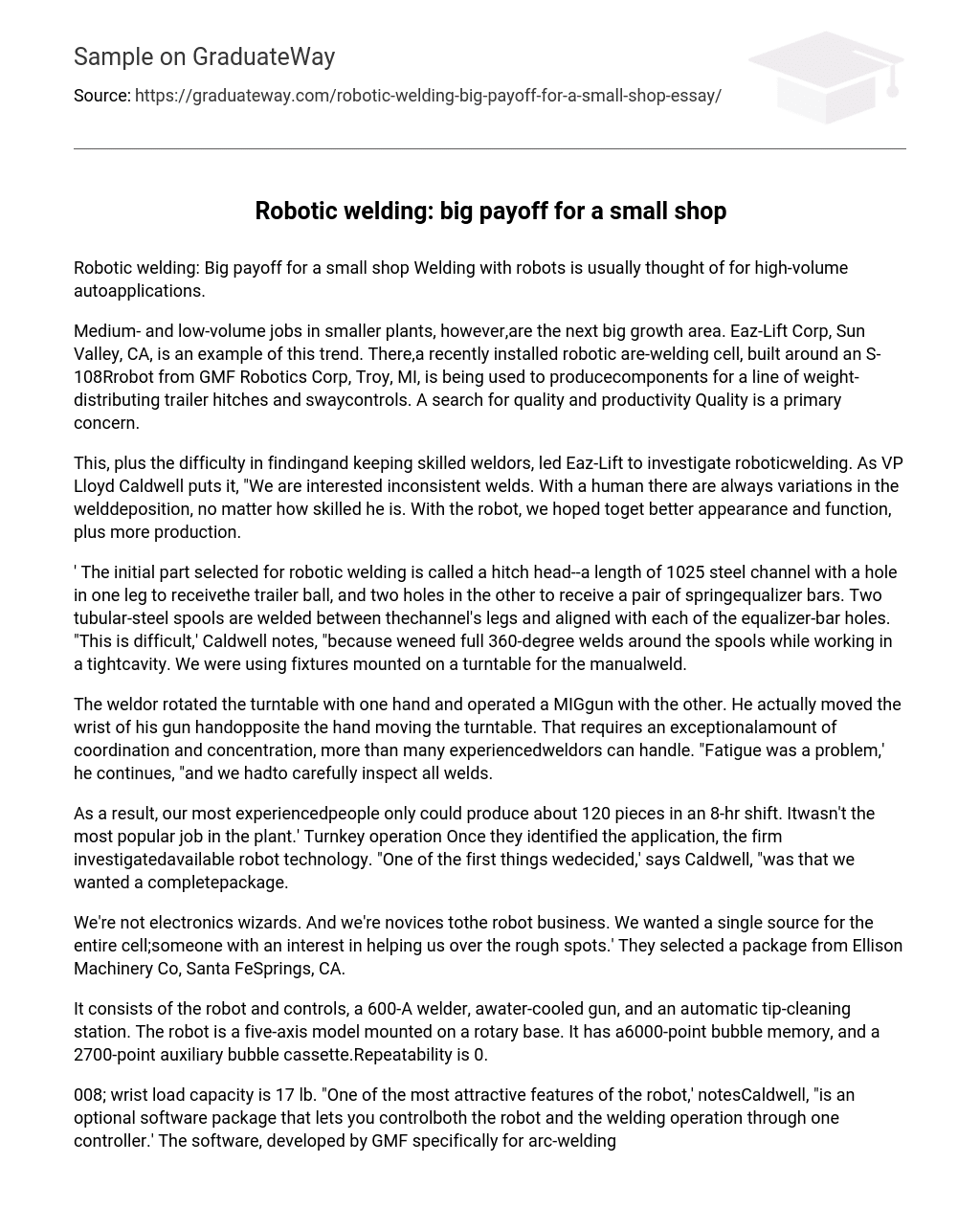Robotic welding: Big payoff for a small shop Welding with robots is usually thought of for high-volume autoapplications.
Medium- and low-volume jobs in smaller plants, however,are the next big growth area. Eaz-Lift Corp, Sun Valley, CA, is an example of this trend. There,a recently installed robotic are-welding cell, built around an S-108Rrobot from GMF Robotics Corp, Troy, MI, is being used to producecomponents for a line of weight-distributing trailer hitches and swaycontrols. A search for quality and productivity Quality is a primary concern.
This, plus the difficulty in findingand keeping skilled weldors, led Eaz-Lift to investigate roboticwelding. As VP Lloyd Caldwell puts it, “We are interested inconsistent welds. With a human there are always variations in the welddeposition, no matter how skilled he is. With the robot, we hoped toget better appearance and function, plus more production.
‘ The initial part selected for robotic welding is called a hitch head–a length of 1025 steel channel with a hole in one leg to receivethe trailer ball, and two holes in the other to receive a pair of springequalizer bars. Two tubular-steel spools are welded between thechannel’s legs and aligned with each of the equalizer-bar holes. “This is difficult,’ Caldwell notes, “because weneed full 360-degree welds around the spools while working in a tightcavity. We were using fixtures mounted on a turntable for the manualweld.
The weldor rotated the turntable with one hand and operated a MIGgun with the other. He actually moved the wrist of his gun handopposite the hand moving the turntable. That requires an exceptionalamount of coordination and concentration, more than many experiencedweldors can handle. “Fatigue was a problem,’ he continues, “and we hadto carefully inspect all welds.
As a result, our most experiencedpeople only could produce about 120 pieces in an 8-hr shift. Itwasn’t the most popular job in the plant.’ Turnkey operation Once they identified the application, the firm investigatedavailable robot technology. “One of the first things wedecided,’ says Caldwell, “was that we wanted a completepackage.
We’re not electronics wizards. And we’re novices tothe robot business. We wanted a single source for the entire cell;someone with an interest in helping us over the rough spots.’ They selected a package from Ellison Machinery Co, Santa FeSprings, CA.
It consists of the robot and controls, a 600-A welder, awater-cooled gun, and an automatic tip-cleaning station. The robot is a five-axis model mounted on a rotary base. It has a6000-point bubble memory, and a 2700-point auxiliary bubble cassette.Repeatability is 0.
008; wrist load capacity is 17 lb. “One of the most attractive features of the robot,’ notesCaldwell, “is an optional software package that lets you controlboth the robot and the welding operation through one controller.’ The software, developed by GMF specifically for arc-weldingapplications, lets an operator combine programming robot motions andwelding parameters, including multiple weave patterns. It handles up to32 sets of variables for voltage, wire-feed rate, shield-gas preflow andpostflow times, and crater-fill duration.
Nearly all are programmedthrough a teach pendant; wire feed and voltage can be adjusted whilewelding. Another aspect of the arc-welding software that proved helpful isthe ability to transfer a motion pattern from one point to another.”The cell is set up to weld 12 hitch heads at a time,’comments Caldwell. “They’re fixtured on three tables arrangedin a semicircle around the robot.
“After the first weld was programmed, it was just a matter ofmoving the pattern to each of the remaining 11 locations with asubroutine. Once we learned how, that capability saved a lot ofprogramming time.’ According to Welding Shop Foreman Jack Fisk, “I had no qualmsabout building fixtures and getting the cell set up. Still, I knewsooner or later I was going to have to make it work.
And I’d neverprogrammed anything before. I found, though, that programming reallyisn’t that difficult. The software helps, especially for thingslike circular interpolation, which saves time on this part.’ On the floor One operator tends the cell, keeping the fixtures loaded,monitoring the robot, and performing simple maintenance andtroubleshooting.
Each hitch head is manually preassembled and tackwelded before the robotic finish welding. Although the entire processcould be automated, current production volumes don’t justify thetooling expense. “We had to make adjustments in the tack weld locations,’says Fisk, “because the robot had trouble getting into certainareas of the hitch head. We just moved the tack welds into those areasto solve the problem.
I guess that shows that robots need people asmuch as we need them. “The robot is more consistent than a man ever could be,’continues Fisk. “You can see the consistency in our use ofconsumables like wire and shielding gas. There’s little day-to-dayvariation.
And consistency seems to translate directly as improvedquality. Now, we’re confident every weld is a good one. “One more thing,’ he adds. “Weld height isimportant because the sleeves are drilled after welding.
If the weld istoo high we break tools. That just doesn’t happen with therobotically welded hitch heads.’ A relatively hot weld (27-V/116-ipm wire feed) and a 95:5argon/oxygen gas mix is used to produce a spray transfer conditionduring processing. This results in a virtually spatter-free weld thatrequires a minimum of secondary grinding and cleaning.
Weld qualityalso is enhanced by cleaning the tip after every 12 parts with theautomatic cleaning station built into the cell. In evaluating the welding cell, Caldwell concludes, “Right nowwe’re producing about 200 good parts per shift with the robot. Iexpect we’ll soon get that up to 240 per shift, or double what aman could do. Of course, we already run the robot during lunch andcoffee breaks.
We plan to stagger the use of two trained operators sothe robot can run 10 hr a day. “Also, we’re realizing savings in secondary operationslike cleaning and drilling, and our scrap rate is down. But, I thinkthe best evidence of our satisfaction with robotic welding is the factthat Jack Fisk is building fixtures for several additional parts rightnow. They’ll be interchangeable with the one’s in the cell.As far as I’m concerned, this is only the beginning.’





